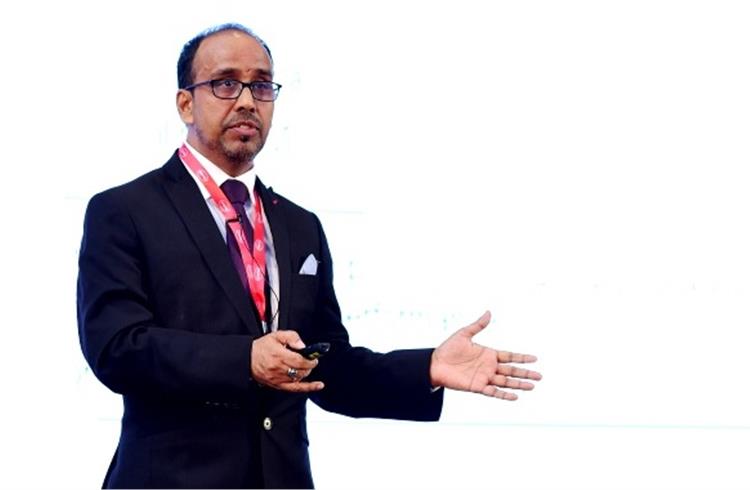‘There is a lot of resistance in India to pay for lightweighting and there is big cost pressure, unique to the Indian market.’
IMEA's PK Verma explains the growth drivers for the company's India business, dealing with cost pressures while chasing weight reduction and leveraging international ties with global OEMs in India.
PK Verma, Regional Steering Unit Manager — Acoustic & Structural, IMEA explains the growth drivers for the company's India business, dealing with cost pressures while chasing weight reduction and leveraging international ties with global OEMs in India. An interview by Shourya Harwani.
What are the growth drivers for your India business?
The market is expanding as the quality of cars improves and leads to an increased content per vehicle for Henkel’s automotive products. The average use of acoustic and structural products in India ranges between 2-4 euros per vehicle but the recent launches are in the range of 6-8 euros per vehicle. However, even this is much lower than that of Europe or USA where content per vehicle is more than 15 euros.
As regards India, the impending crash and emission regulations and lightweighting strategies being adopted by OEMs engender challenges and opportunities. Designers are using alternate solutions in terms of substrates and joining technologies. This also provides a great opportunity for Henkel India to provide design solutions.
Which specific vehicle segments does Henkel India target to drive lightweighting benefits?
We are not focusing on any specific vehicle segments as each segment has its own unique challenges and opportunities. Considering that the Indian market is dominated by small cars, cost causes a big challenge compared to medium or luxury cars in using Henkel’s solutions. Nonetheless, now OEMs have started realising the value of our solutions, and are exploring these solutions for achieving their lightweighting targets without compromising on safety and crash parameters, which is otherwise a big challenge.
How open are OEMs and component suppliers when it comes to using high-performance polymers, which are both strong as well as light?
OEMs and component suppliers are now open to discussions and are willing to explore these alternative technologies, as they also face the challenge of achieving lightweighting with traditional steel and spot welds. The issue is not about how open are they but their readiness to pay for these solutions and involve us at an early design stage.
The awareness level is very high among Indian OEMs, with each one setting up a target for lightweighting with new model launches. However, there is still a gap when it comes to exploring the full potential of these innovative technologies.
How are the cost pressures dealt with while chasing weight reduction and similar technologies?
There is a big cost pressure, which is unique to the Indian market. Moreover, there is a lot of resistance to pay for lightweighting. There have to be very clear measurables to gain in terms of lightweighting versus the amount paid for achieving targets.
What are the top three key areas within technologies surrounding adhesives and polymers to cut down vehicle weight in a cost-effective manner?
- These solutions must be discussed and designed at a very early stage of design / product launch for the most effective design.
- The overall cost of solutions must be considered as these innovative technologies not only improve performance but also simplify processes, and reduce wastage and energy consumption.
- A common design across many models and scale will help reduce cost.
Are you already leveraging your international ties with global OEMs in India?
Yes, as a truly global organisation, we leverage our relationships with global OEMs in India. Our strategy focuses on having a similar team structure and capabilities in India as in other parts of the world, so that an OEM has the same level of comfort and confidence while dealing with the local team or when working on a global car model’s launch.
Recommended: Henkel looks to bond better with Indian automakers
This interview was first published in Autocar Professional's November 1, 2016, 'Lightweighting Special' issue.
RELATED ARTICLES
‘We believe there will be demand for ICE way beyond 2050’: Arnd Franz, Chairman and CEO, Mahle Group
Arnd Franz, CEO of Mahle Group, is optimistic about the company’s expansion in the country — especially with ICE vehicle...
BRANDED CONTENT: 'We aspire to be among the leading sensors and electro-mechanical products manufacturer'
P. Parthasarathy, Founder & Managing Director, Rotary Electronics Pvt Ltd shares the company's commitment and vision to ...
‘Big opportunity for startups lies in products in India’: Detlev Reicheneder
As electrification levels the playing field, the focus on tech and R&D to bring innovative products is the mantra for st...





 By Shourya Harwani
By Shourya Harwani
 17 Nov 2016
17 Nov 2016
 5824 Views
5824 Views









